市场资讯及洞察

Most traders understand EA portfolio balance through the lens of traditional risk management — controlling position sizes, diversifying currency pairs, or limiting exposure per trade.
But in automated trading, balance is about deliberately constructing a portfolio where different strategies complement each other, measuring their collective performance, and actively managing the mix based on those measurements.
The goal is to create a “book” of EAs that can help diversify performance over time, even when individual strategies hit rough patches.
A diversified mix of EAs across timeframes and assets can, in some cases, reduce reliance on any single strategy. This approach reduces dependency on any single EA’s performance, smooths your overall equity curve, and builds resilience across changing market conditions.
It’s about running the right mix, identifying gaps in your coverage, and viewing your automated trading operation as an integrated whole rather than a collection of independent systems.
Basic Evaluation Metrics – Your Start Point
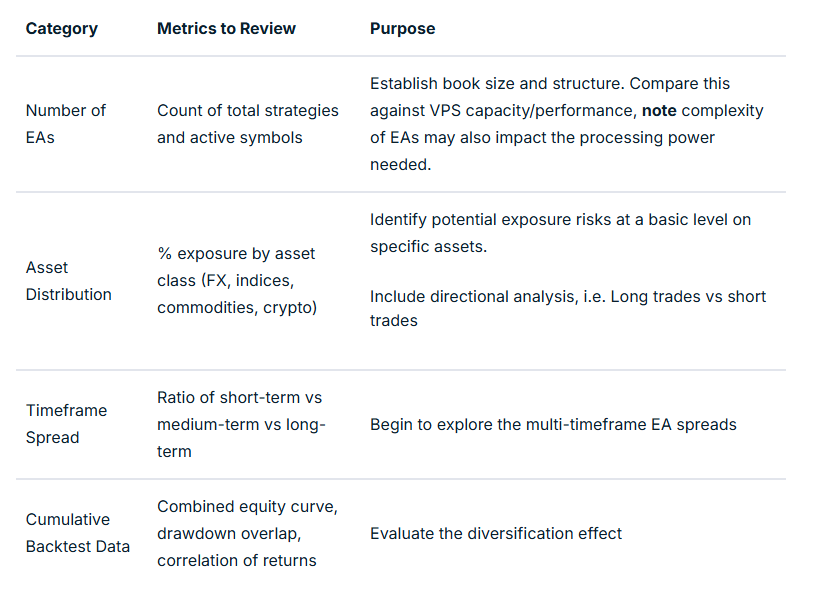
Temporal (timeframe) Balancing
When combined, a timeframe balance (even on the same model and instrument) can help flatten equity swings.
For example, a losing phase in a fast-acting M15 EA can often coincide with a profitable run in an H4 trend model.
Combining this with some market regime and sessional analysis can be beneficial.
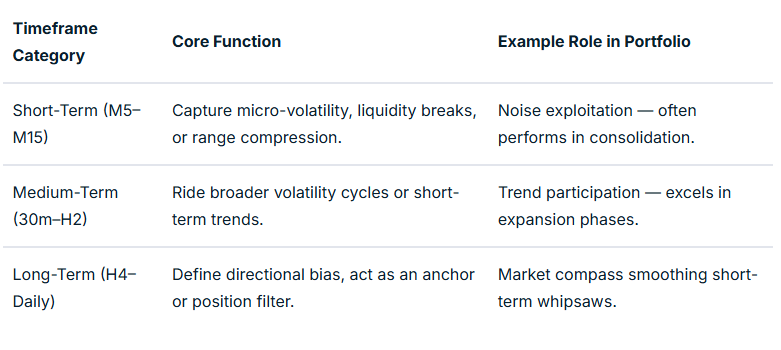
Asset Balance: Managing Systemic Correlation Risk
Running five different EAs on USDJPY might feel diversified if each uses different entry logic, even though they share the same systemic market driver.
But in an EA context, correlation measurement is not necessarily between prices, but between EA returns (equity changes) relating to specific strategies in specific market conditions.
Two EAs on the same symbol might use completely different logic and thus have near-zero correlation.
Conversely, two EAs on a different symbol may feel as though they should offer some balance, but if highly correlated in specific market conditions may not achieve your balancing aim.
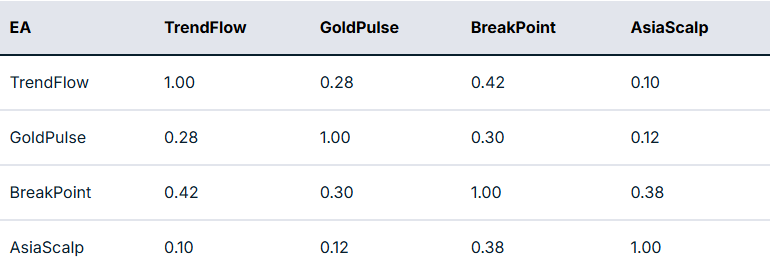
In practical terms, the next step is to take this measurement and map it to potential actionable interventions.
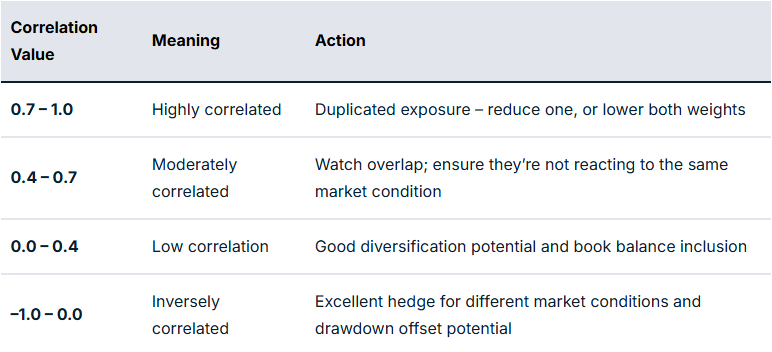
For example, if you have a EURUSD Trend EA and a GBPUSD Breakout EA with a correlation of 0.85, they are behaving like twins in performance related to specific market circumstances. And so you may want to limit exposure to some degree if you are finding that there are many relationships like this.
However, if your gold mean reversion EA correlates 0.25 compared to the rest of your book, this may offer some balance through reducing portfolio drawdown overlap.
Directional and Sentiment Balance
Markets are commonly described as risk-on or risk-off. This bias at any particular time is very likely to impact EA performance, dependent on how well balanced you are to deal with each scenario.
You may have heard the old market cliché of “up the staircase and down the elevator shaft” to describe how prices may move in alternative directions. It does appear that optimisation for each direction, rather than EAs that trade long and short, may offer better outcomes as two separate EAs rather than one catch-all.
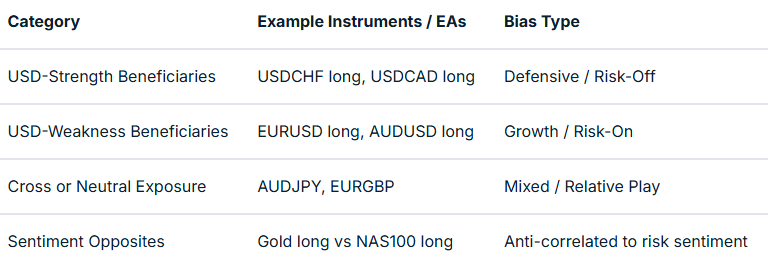
Market Regime and Volatility Balance
Trend and volatility states can have a profound impact on price action, whether as part of a discretionary or EA trading system. Much of this has a direct relationship to time of day, including the nature of individual sessions.
We have a market regime filter that incorporates trend and volatility factors in many EAs to account for this. This can be mapped and tested on a backtest and in a live environment to give evidence of strategy suitability for specific market conditions.
For example, mean reversion strategies may work well in the Asian session but less so in strongly trending markets and the higher volatility of the early part of the US session.
As part of balancing, you are asking questions as to whether you actually have EA strategies suited to different market regimes in place, or are you using these together to optimise book performance?
The table below summarises such an approach of regime vs market mapping:
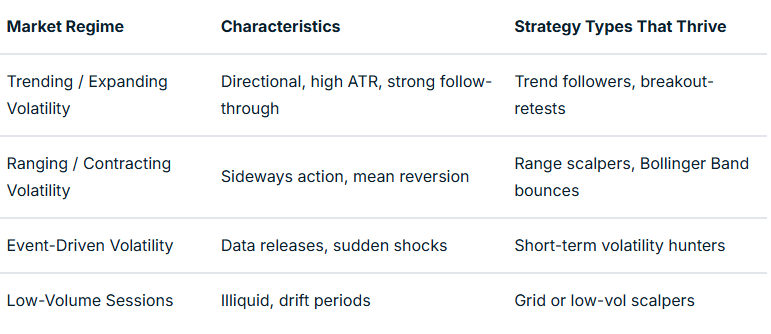
Multi-Level Analysis: From Composition to Interaction
Once your book is structured, the challenge is to turn it into something workable. An additional layer of refinement that turns theory and measurement into something meaningful in action is where any difference will be made.
This “closing the circle” is based on evidence and a true understanding of how your EAs are behaving together. It is the step that takes you to the point where automation can begin to move to the next level.
Mapping relationships with robust and detailed performance evaluation will take time to provide evidence that these are actually making a difference in meeting balancing aims.
To really excel, you should have systems in place that allow ongoing evaluation of the approaches you are using and advise of refinements that may improve things over time.
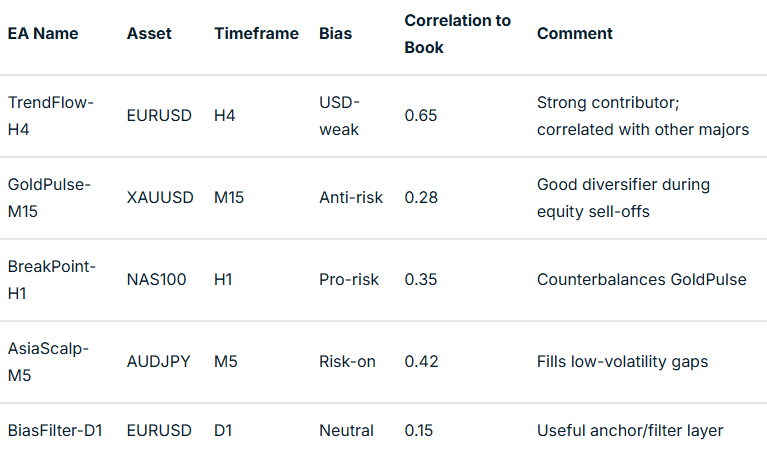
What Next? – Implementing Balance in Practice
Theory must ultimately translate into an executable EA book. A plan of action with landmarks to show progress and maintain motivation is crucial in this approach.
Defining classification tags, setting risk weights, and building monitoring dashboards are all worth consideration.
Advanced EA traders could also consider a supervisory ‘Sentinel’ EA, or ‘mothership’ approach, to enable or disable EAs dynamically based on underlying market metrics and external information integrated into EA coding decision-making.
Final Thoughts
A balanced EA portfolio is not generated by accident; it is well-thought-out, evidence-based and a continuously developing architecture. It is designed to offer improved risk management across your EA portfolio and improved trading outcomes.
Your process begins with mapping your existing strategies by number, asset, and timeframe, then expands into analysing correlations, directional bias, and volatility regimes.
When you reach the stage where one EA’s drawdown is another’s opportunity, you are no longer simply trading models but managing a system of EA systems. To finish, ask yourself the question, “Could this approach contribute to improved outcomes over time?”. If your answer is “yes,” then your mission is clear.
If you are interested in learning more about adding EAs to your trading toolbox, join the new GO EA Programme (coming soon) by contacting [email protected].


最近,特朗普一句话 “退休账户也可以买数字货币!”直接像给烧烤架泼了桶酒精,整个数字货币市场“呼”地燃了起来。比特币、以太坊接连冲高,连带着几家“买币当家业”的上市公司股价也跟着蹦起来。今天咱就用大白话聊聊这四家代表公司:1. MSTR(Strategy)——“比特币仓库”这家公司原名 MicroStrategy,本来是做企业数据分析软件的。但老板 Michael Saylor 心想:“美元放银行会贬值,不如换成比特币!”于是从 2020 年开始,MSTR疯狂买 BTC,不光用公司利润买,还发行债券、卖股票筹钱买。现在他们手里有 58 万多枚比特币,按市价算价值六百多亿美元!玩法很简单:融资 → 买币 → 币价涨 → 资产变多 → 股价也涨 → 再融资 → 再买币股民直接把它当成“比特币股票化”,想投 BTC 但不想自己存币,就买它的股票。当然,币价要是跌,账面就跟坐滑梯一样。2. SBET(SharpLink Gaming)——“以太坊版 MSTR”SBET 原来是个小型科技公司,2025 年突然转型:拉来 4 亿多美元,直接买了十几万枚以太坊(ETH)。买了币不闲着,还拿去质押,年化收益 7%-8%。随着 ETH 涨价,SBET 的股票一个月飙了 140%,还跑到纳斯达克敲钟庆祝自己是全球最大以太坊上市公司。一句话总结:SBET 就是把 MSTR 的套路搬到以太坊身上,还加了“利息”这个buff。3. BMNR(BitMine)——ETH 财库新对手BMNR 原来是挖比特币的矿企,后来觉得 ETH 更有潜力,于是转型走“以太坊财库”路线。操作流程:私募融资 2.5 亿美元买 ETH买到手后继续融资、继续买宣布股票回购计划,把股价托上去玩质押、DeFi,把 ETH 用到极致现在它和 SBET 形成了竞争关系。ETH 波动比 BTC 大,赚得多的时候更猛,但跌起来也更疼。4. TRON(波场)——借壳上市的 TRX 财库TRON 是孙宇晨创立的公链项目,这次他们也想玩上市公司财库模式。具体做法:找一家纳斯达克上市公司,通过反向并购变成“Tron Inc.”,然后宣布——我们是全球最大上市 TRX 持有公司,手里有 3.65 亿多枚 TRX,还会质押拿收益。这个故事性十足。四家公司小对比

小结这四家公司把数字货币搬进上市公司的金库,通过股票让投资者间接参与市场。政策利好为他们打开了更多资金渠道,但币价涨跌波动大,投资者心态要稳,不要被短期涨幅冲昏头脑。联系方式:墨尔本 03 8658 0603悉尼 02 9188 0418中国地区(中文) 400 120 8537中国地区(英文) +248 4 671 903作者:Mill Li | GO Markets 墨尔本中文部


隔夜美股延续强势走势,纳斯达克与标普500高开低走但依旧收阳,道琼斯指数则持续上行。投资者的目光再度集中在美联储9月降息预期上——市场传出有官员支持一次性降息50个基点的观点,引发关注。科技板块方面,美国政府与英伟达、AMD达成的芯片收入分成协议成为热点话题,白宫还透露该机制或将扩展至其他企业。与此同时,数字货币领域全面走高,比特币突破历史高点,以太坊再度刷新纪录,新近上市的“Bullish”凭借美国本土背景备受追捧,首日暴涨逾83%,盘后再涨近10%,上演一场资本市场的“速度与激情”。今日市场焦点转向澳大利亚与美国经济数据。澳洲将公布最新失业率数据,预期小幅回落或缓解澳联储降息压力;美国方面,PPI数据将在今晚发布,或对美元与通胀预期产生短期影响。个股表现上,部分上半年新上市的明星股出现回调压力:CRWV财报不及预期,股价大跌20%跌破120美元支撑;CRCL宣布增发1000万股,股价下挫逾6%,未能站稳160美元关口。澳股今日则出现补涨行情,银行股反弹削弱昨日下跌带来的拖累;资源板块中,澳铀价格小幅反弹,但SLX股价回落至增发价。汇市方面,澳元兑美元继续走强,日元表现坚挺,带动美元兑日元与澳元兑日元均回落。美元兑人民币跌破7.18关口,澳元兑人民币稳定在4.70附近。尽管澳联储降息对澳元构成利空,但美元因降息预期升温而走弱,反而间接支撑了澳元与人民币的相对稳定。贵金属方面,金价明显反弹,油价则持续下行,市场风险情绪依旧偏乐观。联系方式:墨尔本 03 8658 0603悉尼 02 9188 0418中国地区(中文) 400 120 8537中国地区(英文) +248 4 671 903作者:Xavier Zhang | GO Markets 高级分析师


上周五,美股再度走高,市场情绪受到多重利好推动。美国最新行政令鼓励养老金入市,带动虚拟货币板块全面上涨,以太坊创下历史新高,比特币逼近12万美元关口。周末行情的火热,也为新一周市场定下了积极基调。本周金融市场看点颇多。澳大利亚方面,周二澳联储将公布利率决议,市场普遍预期降息25个基点,周四将发布最新失业率,预计较前值小幅回落至4.2%。美国方面,周二CPI数据即将公布,市场预测同比增速在2.8%左右,略高于前值2.7%,若符合预期,对市场冲击有限。目前,美联储在人员调整之际,市场普遍认为9月降息几乎已成定局,部分机构甚至预计降息幅度可能达到50个基点。周四将迎来PPI数据,周五则是被称为“恐怖数据”的零售销售月率,预计环比变动不大。此外,热门公司OKLO、CRWV、CRCL等将陆续发布财报,或将引发短期交易机会。外汇与大宗商品方面,美元指数本周或随数据公布小幅波动。CPI若略超预期可能短暂支撑美元,而零售销售若走弱则可能施压美元。黄金价格近期承压,短期或难守住3400美元/盎司关口;油价则继续下探,市场情绪保持谨慎。外汇市场早盘整体平稳,澳元兑日元保持在0.65上方,美元兑日元在148附近震荡,美元兑人民币徘徊于7.19,澳元兑人民币呈现一定升势。总体来看,本周市场焦点集中在澳美利率政策、通胀数据与大宗商品走势,投资者可关注降息预期与风险资产表现的互动变化。联系方式:墨尔本 03 8658 0603悉尼 02 9188 0418中国地区(中文) 400 120 8537中国地区(英文) +248 4 671 903作者:Xavier Zhang | GO Markets 高级分析师


Scaling in and out of positions is one of the most effective ways to maximise opportunity while managing risk. But it is also one of the easiest areas to let emotions take over, rather than having a clear systemised set of rules within a trading plan.If done well, scaling in can help you capitalise on strong trends without taking excessive initial risk, and scaling out can protect profits while still leaving room for the trade to run. If done poorly, it can lead to overexposure, premature exits, and a confused trading record that is difficult to evaluate.
Your Scaling Checklists
By having clearly defined rules for scaling in and out, you remove uncertainty during live market conditions, create consistency, and ensure that each of your trading actions aligns closely with your overall risk and performance objectives.Use the checklists below to help create your own rules and integrate these criteria into your written trading plan.
Scaling In Checklist:
CategoryChecklist ItemPre-Trade Plan for ScalingScaling strategy defined before entry (pyramiding, fixed lot add-on, % equity add-on, etc.) Maximum total exposure per instrument set (lots or % of account) Price level(s) or technical conditions for add-ons are pre-defined Risk per add-on is calculated, sothe combined stop placement keeps the total risk within the planTechnical & Market Conditions CheckOriginal trade is already in profit by a set buffer (e.g., +1R or above breakeven) Market structure still supports the trade thesis (trend intact, no reversal signs) Key support/resistance is not immediately ahead of the price Volatility and liquidity remain healthy — no widening spreads or news shock riskExecution RulesAdd-on triggered by pre-defined signal — technical pattern, breakout, retracement entry Stop-loss for add-on set, so the combined position risk is controlled Position size adjusted to account for existing open risk All add-ons logged in a journal with rationale and levelRisk ContainmentHave a defined cap on the number of scale-ins (e.g., max 3 total entries per trade) Combined positions’ stop reviewed and adjusted where appropriate Portfolio correlation checked — scaling in doesn’t overexpose to a single asset class
Scaling Out Checklist:
CategoryChecklist ItemPre-Defined Scaling Out RulesProfit targets for partial closes set in advance (price levels, trailing stops, % move) Minimum portion to leave running defined — e.g., 25% of position Scaling method chosen, e.g., fixed lots, % of original size, ATR-based, or structure-basedMarket & Trade Condition CheckPrice has reached the first profit-taking zone (support/resistance, measured move, fib level) Technical signs of slowing momentum or potential reversal are visible Volatility spike or news risk approaching that could threaten open profits Trade has met or exceeded the minimum R target — e.g., 2RExecution RulesPartial close executed according to plan — no hesitation or emotional overrides Stop-loss on remaining position tightened if conditions warrant Take-profit levels for the remaining position are re-evaluated after partial closePost-Scale ReviewDocument in journal: reason for scaling out, % closed, remaining size, new stop Track performance impact of scaling — did partial exits improve net profitability or reduce potential gains? Adjust future scaling-out rules based on review data
Final Thoughts
The goal of scaling in and out is not to make a trade “feel” safer or more profitable, but to execute a pre-planned sequence of actions that have the potential to enhance your overall performance and better meet your trading goals. Whether you are attempting to add to an existing position or lock in gains for a specific trade, every adjustment should be intentional, tested, and documented.This disciplined approach can help turn your scaling approaches into something of consistent benefit, rather than a hit-or-miss, heat-of-the-moment type of tactic that most traders use.
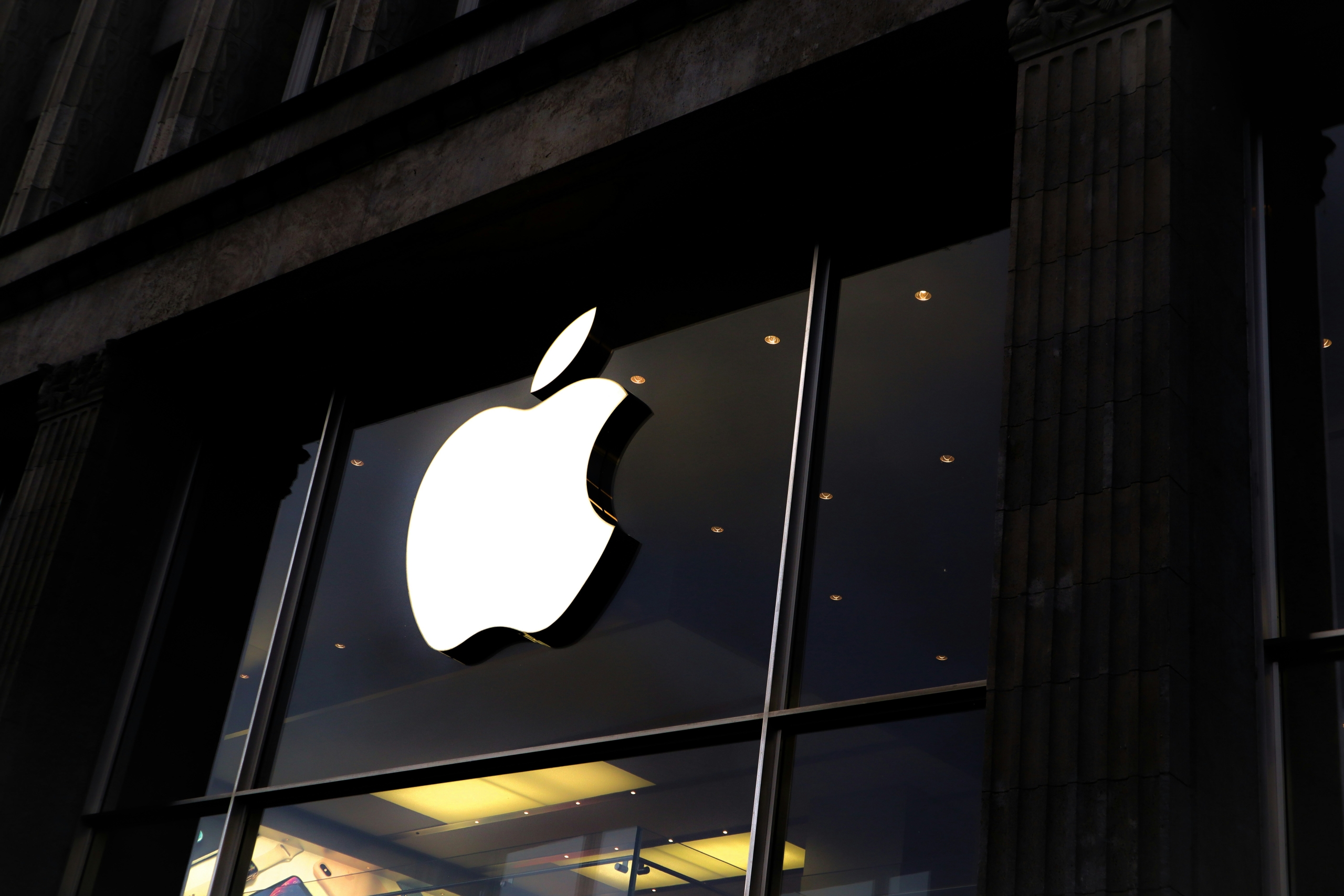

最近苹果股价连涨两天,有人看不懂:不是说库克躺平了吗?不是说苹果AI跟不上了吗?为啥反而涨了?别急,看完你就懂,这不仅仅是个“股价回暖”的问题,这是苹果在两个大雷上完成了“拆弹”,而且还送了个金的!一、24K金底座,库克给特朗普下了什么注?据多方爆料,库克最近悄悄送了一件特别定制的礼物给特朗普——一块印有苹果Logo、镶着24K金底座的定制玻璃雕塑。这个操作看起来很“软”,但效果极其“硬”。配合上苹果宣布的重大承诺:6000亿人民币的美国本土投资未来核心零部件在美国制造继续扩大印度组装规模特朗普当场笑开花:你看,这才是“让美国再次伟大”的标杆企业!然后——原本威胁要加征25%关税的事,直接没下文了。也就是说,苹果通过政治斡旋+本土投资,换来了政策安全感,完美避开一颗巨雷:全球供应链转移的不确定性。你以为送礼物只是为了交朋友?在这个时间点,苹果送的那不是玻璃,是盾牌。二、AI之痛,苹果终于动手了我们说苹果这两年的“掉队”,根子就卡在AI。OpenAI在起飞,Google有Gemini,Meta有LLaMA,连特斯拉马斯克也搞出个Grok,结果苹果靠的是啥?——“Siri + GPT接入”。听起来像是清华毕业生,请了个家教再去考中考。但现在,剧情开始反转:苹果传出准备收购AI独角兽,弥补核心大模型技术短板。这家公司虽然名字还没官宣,但苹果账上1660亿美元现金,想买谁就买谁。这个信号非常关键。不是接入GPT这么简单了,而是要真正“补DNA”。苹果不怕花钱,它只怕花了钱,文化不兼容。但现在看,库克终于明白:苹果不能再做“生态附庸”,而要重回“科技领袖”角色。这个动作,一下子让市场从“质疑苹果是否掉队”转向“押注苹果追赶的节奏”。

三、App Store还能割多久?很多人不知道苹果赚钱有多狠。我有个朋友,通过苹果App卖会员,定价5000元,最后到手多少你猜?——2400元。剩下的去哪了?苹果抽成,税费,手续费,一路剥皮。这种“帝国过路费”全球开发者已经忍无可忍,欧盟已经出手,美国也在盯。虽然目前还是苹果的“印钞机”,但未来这部分营收会逐步被削弱,必须靠AI和硬件创新来补位。四、iPhone 17,能不能再来一次“超预期”?苹果今年9月要发 iPhone 17。如果:AI 功能跟得上,硬件配置真升级,再来个换机潮,那就是三连击利好。否则,就只是“多了个钛合金边框”的升级了。不过,考虑到AI和地缘两大风险在同时落地、股价正在修复,9月发布会可能成为真正的风口验证点。五、结语:苹果不是老了,是开始认真了过去一年,苹果最大的问题不是没钱、不是没人才,而是太“佛”了。眼看别人家模型一个比一个强,别人家GPU一个比一个卷,苹果却在用Siri回你:“对不起,我没听懂。”但这次不一样了:对外搞定特朗普,稳住全球供应链;对内补强AI短板,准备出手收购;股价启动,估值不再虚高,市场开始重新定价。曾经“高高在上”的苹果,终于学会了什么叫“市场期待”。当年乔布斯靠极致产品征服世界;现在的库克,靠的是政治智慧和资本调度。也许,这才是真正的“成熟企业”。——苹果没有死,只是终于开始认真对待这个世界的变化了。联系方式:墨尔本 03 8658 0603悉尼 02 9188 0418中国地区(中文) 400 120 8537中国地区(英文) +248 4 671 903作者:Mill Li | GO Markets 墨尔本中文部


美股周二全线收跌,市场重心再度被政策预期主导。多项潜在的新规发布暗示未来一周内药品与半导体领域或将面临关税调整,成为压制科技股表现的重要变量。 01|政策预期主导市场情绪市场昨日的主要波动来源于一系列突发政策讲话,内容涵盖劳工数据可信度、美联储独立性、医药与芯片行业的潜在关税,以及多个区域贸易协定的重新评估。这些信号虽未落实为明确政策,但为接下来的市场走势埋下伏笔,投资者避险情绪明显升温。尤其是医药与半导体关税预期,对相关板块构成直接冲击。此外,近期对多个贸易合作国政策方向的收紧倾向,也加大了市场对全球供应链波动的担忧。 02|芯片财报喜忧参半,核能与量子计算继续爆发半导体板块方面,AMD发布财报虽整体超出市场预期,但利润边际下滑引发股价盘后回调超过5%;英伟达回应芯片安全问题,否认任何监控功能,意图突破出口管制障碍,但市场反应冷淡。相比之下,新能源和科技前沿领域表现强劲。核能概念再度大涨,BWXT涨超17%,OKLO创下历史新高;量子计算板块迎来集体上扬,QUBT、QBTS、RGTI纷纷录得4%-8%的涨幅。中长期投资者可重点关注该领域持续性机会。 03|市场波动加剧,避险资产再度吸金在多重不确定性叠加背景下,避险需求上升。金价再度突破3380美元平台,油价则因需求担忧回落至66美元下方。数字货币方面整体延续调整,比特币平台类股COIN跌破300美元关口。汇率方面,美元指数小幅震荡,非美货币整体波动不大。澳美汇率虽小幅上扬但仍未突破0.65关键位,澳元兑人民币略有升值,站稳4.65上方。整体来看,市场短期不确定性明显增强,操作策略宜侧重防守与结构性机会的挖掘。免责声明:GO Markets 分析师或外部发言人提供的信息基于其独立分析或个人经验。所表达的观点或交易风格仅代表其个人;并不代表 GO Markets 的观点或立场。联系方式:墨尔本 03 8658 0603悉尼 02 9188 0418中国地区(中文) 400 120 8537中国地区(英文) +248 4 671 903作者:Xavier Zhang | GO Markets 高级分析师

